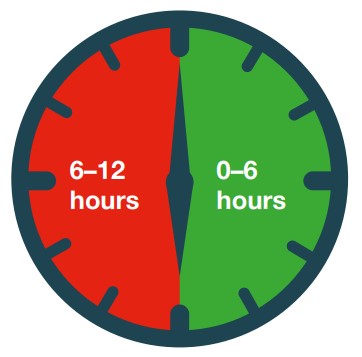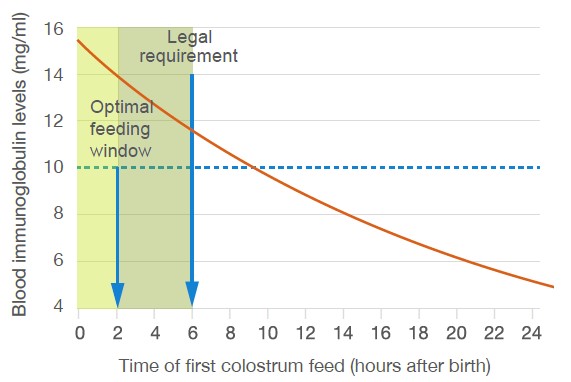- Home
- Knowledge library
- 3 Qs of feeding colostrum
3 Qs of feeding colostrum
Colostrum is vital to the newborn calf because it contains antibodies (also known as immunoglobulins, or IgG), which provide immunity. It is also rich in energy and nutrients that are essential for growth.
Quality
It is important to feed high-quality colostrum that has been measured using a Brix refractometer or colostrometer.
- Good-quality colostrum contains at least 50 g/L of IgG. Any colostrum containing <20 g/L of IgG should not be used
- Colostrum quality declines after six hours
- It is not possible to determine the quality of colostrum by looking at it: it must be tested
- Test colostrum from all cows. Ensure cows are milked as soon as possible after calving so that the best possible colostrum is collected and fed to newborn calves
- Quality declines if the colostrum becomes contaminated with bacteria, so collect and store it hygienically
Colostrum quality declines after six hours

Quantity and quickly
The recommendation is to give a first feed of 3 litres within the first two hours of life. This can be split into two feeds if necessary, particularly for smaller breeds, and should be followed up by another similarly sized feed within 12 hours of birth.
The colostrum should be fed at body temperature of 38°C.
To optimise immunity, it is very important that calves receive their first colostrum feed as soon as possible after birth, ideally within two hours.
Calves lose their ability to absorb antibodies in the first few hours of life. After 10 hours, the calf’s ability to absorb enough IgG is dramatically reduced (see graph below) and by 20 hours after birth, this ability is nearly gone.
Make sure you have a supply of good-quality frozen colostrum from cows of known health status, which can be used if a dam’s own colostrum is of insufficient quality.
Effect of time of first colostrum feed on antibody absorption. After 10 hours, the calf’s ability to absorb enough IgG is dramatically reduced

The ideal time to feed colostrum is within six hours of birth.
- Optimal feeding time for colostrum is within the first two hours of birth, but the legal requirement is within the first six hours of birth
- Feeding colostrum to calves over several days is beneficial for building immunity and fighting infections
Method of feeding
Calves left to suckle their dam are 2.4 times more likely to receive insufficient antibodies. You should, therefore, feed the calf by either:
- Bottle – promotes transit of the colostrum to the true stomach
- Tube feeding – ensures that the full volume of colostrum is received by the calf. This is a skilled technique that can only be done safely by trained staff
If you start using a bottle and the calf does not drink it all, feed the remainder by tube to make sure the calf receives the full 3 litres.
It’s essential to maintain high standards of cleanliness in both feed preparation and housing.
Monitoring
Blood testing your calves tells you about the effectiveness of your colostrum management. Ask your vet to take samples from at least 12 calves within one week of birth. Samples can be tested for either the antibody (IgG) level or the total protein (TP) in the blood. If less than 80% of the group is categorised as ‘good’, examine the potential causes of this.
The table below shows antibody (IgG) and total protein (TP) blood test recommendations.
| Quality | IgGg g/L | TP g/L |
| Good | >12 | >55 |
| Marginal | 10–12 | 50–55 |
| Poor | <10 | <50 |
Future care
Even good-quality colostrum that is fed on time contains limited antibodies. The newborn calf does not yet make its own antibodies. Therefore, it is vital to continue giving good-quality care by:
- Keeping the calf in a suitable environment
- Providing sufficient feed
- Maintaining high standards of cleanliness in both feed preparation and housing
Summary
Feed the right quantity of good-quality colostrum to all calves as soon as possible after birth.
Remember the 3 Qs:
- Quantity – 3 litres
- Quality – contains at least 50 g/L of IgG
- Quickly – within two hours of birth
Useful links
The 3 Qs of feeding colostrum factsheet
If you would like to order a hard copy of the Calf management guide, please contact publications@ahdb.org.uk or call 0247 799 0069.

